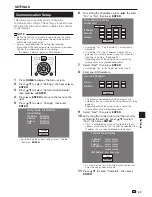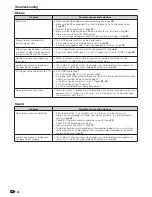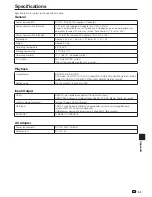
(Continued on the next page)
DVD video (pages 8, 27)
A disc format that contains up to eight hours of moving
pictures on a disc the same diameter as a CD. A single-
layer single sided DVD holds up to 4.7 GB; a double
layer single-sided DVD, 8.5 GB; a single layer double-
sided DVD, 9.4 GB; double-layer double-sided DVD, 17
GB. The MPEG 2 format was adopted for efficient video
data compression. It is a variable rate technology that
encodes the data to according to the status of the video
for reproducing high-quality images. Audio information
is recorded in a multi-channel format such as Dolby
Digital, allowing for a realistic audio presence.
DVD+/-R (pages 8, 27)
A DVD+/-R is a recordable, write-once DVD. Since
contents can be recorded and cannot be overwritten,
a DVD+/-R can be used to archive data or for
storing and distributing video material. The DVD+/-
R has two different formats: VR format and Video
format. DVDs created in Video format have the same
format as a DVD video, while discs created in VR
(Video Recording) format allow the contents to be
programmed or edited.
DVD+/-RW (pages 8, 27)
A DVD+/-RW is a recordable and rewritable DVD. The
re-recordable feature makes editing possible. The
DVD+/-RW has two different formats: VR format and
Video format. DVDs created in Video format have the
same format as a DVD video, while discs created in
VR (Video Recording) format allow the contents to be
programmed or edited.
HDMI (page 19)
HDMI (High-Definition Multimedia Interface) is an
interface that supports both video and audio on
a single digital connection. The HDMI connection
carries standard to high definition video signals
and multi-channel audio signals to AV components
such as HDMI equipped TVs, in digital form without
degradation.
Interlace format
Interlace format shows every other line of an image
as a single “field” and is the standard method for
displaying images on television. The even numbered
field shows the even numbered lines of an image, and
the odd numbered field shows the odd numbered lines
of an image.
JPEG (pages 8, 9, 10, 33)
JPEG (Joint Photographic Experts Group) is a still
image data compression format and is used in most of
digital cameras.
Letter Box (LB 4:3) (page 40)
A screen size with black bars on the top and bottom
of the image to allow viewing of wide-screen (16:9)
material on a connected 4:3 TV.
Linear PCM Sound
Linear PCM is a signal recording format used for Audio
CDs and on some DVD and Blu-ray discs. The sound
on Audio CDs is recorded at 44.1 kHz with 16 bits.
(Sound is recorded between 48 kHz with 16 bits and
96 kHz with 24 bits on DVD video discs and between
48 kHz with 16 bits and 192 kHz with 24 bits on BD
video discs.)
MP3 (pages 8, 9, 10, 32)
MP3 files are audio data compressed in the MPEG1/2
Audio layer-3 file format. “MP3 files” have “.mp3” as
extensions.
MPEG-2
MPEG-2 (Moving Picture Experts Group phase 2) is
one of the video data compression schemes, which
is adopted for DVD videos and digital broadcasts
worldwide. Some Blu-ray Discs also use high bitrate
MPEG-2.
Multi Angle (pages 36–38)
This is a feature of DVD and BD video discs. In some
discs, the same scene is shot from different angles,
and these are stored in a single disc so you can enjoy
playback from each angle. (This function can be
enjoyed if the disc is recorded with multiple angles.)
Multi Audio
This is a feature of DVD and BD video discs. This
function makes it possible to record different audio
tracks for the same video, so you can enhance your
enjoyment by switching the audio. (You can enjoy
this function with discs recorded with multiple audio
tracks.)
Pan Scan (PS 4:3) (page 40)
A screen size that cuts off the sides of the image
to allow viewing of wide-screen (16:9) material on a
connected 4:3 TV.
Parental control (page 41)
In some digital broadcasts and BD/DVD video discs,
a control level for disc viewing is set depending on
the age of the viewer. With this Player, you can set the
control level for viewing such broadcasts and discs.
Pop-up menu (page 28)
An enhanced menu operation available on BD video
discs. The pop-up menu appears when
POP-UP
MENU
is pressed during playback, and can be
operated while playback is in progress.
Progressive format
Compared to the Interlace format that alternately
shows every other line of an image (field) to create one
frame, the Progressive format shows the entire image
at once as a single frame. This means that while the
Interlace format can show 30 frames/60 fields in one
second, the Progressive format can show 60 frames in
one second. The overall picture quality increases and
still images, text, and horizontal lines appear sharper.
Glossary
55
Appendix
Содержание BD-HP90RU
Страница 61: ...Memo 59 ...
Страница 62: ...Memo 60 ...
Страница 63: ......
Страница 64: ...SHARP CORPORATION xxxxxxxxxx Printed in China TINS E962WJQZ 10P10 CH NG ORCxxxx A ...








































